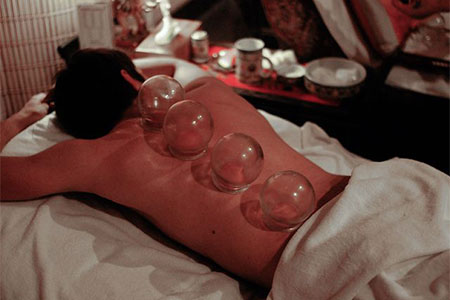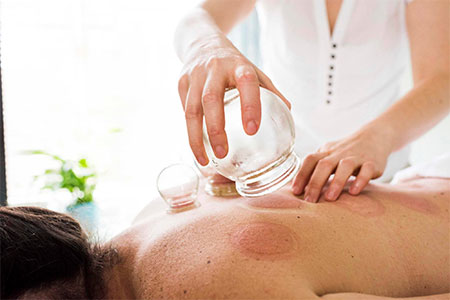What is Cupping?
The practice of cupping can be traced back thousands of years. Ge Hong, a famous Taoist alchemist and herbalist, first practiced cupping around 1800 years ago. Ancient cupping was generally performed using animal horns. As time progressed, so did the materials used for cupping, from bamboo to ceramic to glass. Suction was primarily created through the use of heat, cups would be heated with fire and then applied to the skin. As the cups cooled, they would draw the skin inside and release toxins from the body. Today, cupping is often performed using glass cups that are rounded like balls and open on one end. We perform cupping in our Burlington office for patients all across southeastern Wisconsin and northern Illinois, including Madison, Lake Geneva, Racine, and Milwaukee residents.
Modern cupping has two main categories:
- Dry Cupping: A suction-only method, the cup is set in place for a set time, usually between 5 and 10 minutes. Most common.
- Wet Cupping: May involve both suction and controlled medicinal bleeding. Cups are typically only in place for a few minutes before the practitioner removes the cup and makes a small incision to draw blood.
What to Expect
During treatment, a heated cup is placed on the skin and suctions into place. The cup is often heated with fire using alcohol, herbs, or paper that is placed directly into the cup. Once the fire source is removed, the heated cup is placed with the open side directly on your skin. When the hot cup is placed on to your skin, the air inside the cup cools and creates a vacuum that will pull the skin and muscle into the cup. Your skin may turn red as the blood vessels adjust to the change in pressure.
After the cups are removed, the practitioner may cover the previously cupped areas with ointment and bandages. Mild bruising or other marks may occur, however, these usually go away within 10 days of your session.
Cupping is often performed along with an acupuncture treatment. For best results, you may want to fast or eat only a light meal in the two to three hours leading up to your cupping session.


What Can Cupping Treat?
Cupping is used to help remedy several problems, including back pain, neck pain, & headaches, as well as a wide variety of other conditions, including muscle tension for athletes.
Since cups can be applied to major acupressure points, this practice is also thought to be effective at treating digestive issues, skin issues, and other conditions commonly treated with acupressure. Other conditions it is thought that cupping may help treat include:
- Shingles
- Detoxification
- Cough and Dyspnea
- Acne
- Weight Loss
Possible Side Effects
There aren't generally side effects found or associated with cupping. However, if there are any, you may experience them during your treatment or immediately after. If you experience any of these issues, consult your practitioner. These can include:
- Lightheaded or dizzy during your treatment
- Sweating
- Nausea
You may also find, after treatment, the skin around the rim of the cup may become irritated and marked in a circular pattern, but these generally fade over time.
Call our team at Oriental Healing Oasis & Wellness Center in Burlington today to set up an appointment or answer any questions you may have about our cupping treatments!

